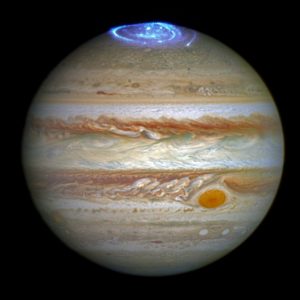Good morning, Whitewater.
A new month begins, on a day with increasing sunshine and a high of seventy-four. Sunrise is 5:20 AM and sunset 8:36 PM, for 15h 15m 58s of daytime. The moon is a waning crescent with 12.1% of its visible disk illuminated.
Using the Hubble Space Telescope, astronomers from NASA and the European Space Agency saw and recorded astonishing auroras on Jupiter:
Jupiter, the largest planet in the Solar System, is best known for its colourful storms, the most famous being the Great Red Spot. Now astronomers have focused on another beautiful feature of the planet, using the ultraviolet capabilities of the NASA/ESA Hubble Space Telescope.
The extraordinary vivid glows shown in the new observations are known as auroras[1]. They are created when high energy particles enter a planet’s atmosphere near its magnetic poles and collide with atoms of gas. As well as producing beautiful images, this programme aims to determine how various components of Jupiter’s auroras respond to different conditions in the solar wind, a stream of charged particles ejected from the Sun.
This observation programme is perfectly timed as NASA’s Juno spacecraft is currently in the solar wind near Jupiter and will enter the orbit of the planet in early July 2016. While Hubble is observing and measuring the auroras on Jupiter, Juno is measuring the properties of the solar wind itself; a perfect collaboration between a telescope and a space probe [2].
On this day in 1863, the Battle of Gettysburg begins:
After his success at Chancellorsville in Virginia in May 1863, Lee led his army through the Shenandoah Valley to begin his second invasion of the North—the Gettysburg Campaign. With his army in high spirits, Lee intended to shift the focus of the summer campaign from war-ravaged northern Virginia and hoped to influence Northern politicians to give up their prosecution of the war by penetrating as far as Harrisburg, Pennsylvania, or even Philadelphia. Prodded by PresidentAbraham Lincoln, Maj. Gen. Joseph Hooker moved his army in pursuit, but was relieved of command just three days before the battle and replaced by Meade.
Elements of the two armies initially collided at Gettysburg on July 1, 1863, as Lee urgently concentrated his forces there, his objective being to engage the Union army and destroy it. Low ridges to the northwest of town were defended initially by a Union cavalry division under Brig. Gen. John Buford, and soon reinforced with two corps of Union infantry. However, two large Confederate corps assaulted them from the northwest and north, collapsing the hastily developed Union lines, sending the defenders retreating through the streets of town to the hills just to the south.
On this day in 1967, it becomes legal to sell margarine in Wisconsin:
1967 – Sale of Oleo Becomes Legal
On this date it became legal to purchase Oleomargarine in Wisconsin. For decades, margarine was considered a contraband spread. Sale of the butter impost0r resulted in fines or possible jail terms. Oleomargarine was sold legally in Illinois and frequently smuggled into Wisconsin.
A Google a Day asks a science question: “What is the atomic weight of the lightest element on the periodic table?”

